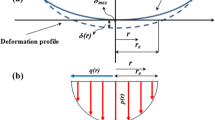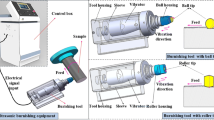Abstract
Burnishing is a surface treatment process widely used to improve fatigue and corrosion resistance of metal components by introducing a compressive residual stress layer. However, the measurement of residual stress by X-ray diffraction is expensive, time consuming, and tedious. Hole drilling method is quick and simple, but it is destructive and provides limited resolution in depth direction. This work presents a quick method to determine the nature and magnitude of residual stress by using Almen strips. Inspired by the application of Almen strips in shot peening, the deflection of the burnished Almen strips under different burnishing conditions were measured. In addition, a finite element simulation model has been developed to predict residual stresses and deflection which were compared with the experimental results. Contact conditions with different combinations of sliding and rolling were investigated in the simulations to understand the contact nature in a burnishing process. It was found that the deflection of Almen strip reflects the magnitude and penetration depth into subsurface of the induced residual stress. The contact condition during burnishing is either pure sliding or a mixed mode of sliding and rolling, but not pure rolling.




















Similar content being viewed by others
References
Klocke F, Liermann J (1998) Roller burnishing of hard turned surfaces. Int J Mach Tools Manuf 38(5):419–423
Prevéy PS, Jayaraman N, Cammett J (2005) Overview of low plasticity burnishing for mitigation of fatigue damage mechanisms. In: Proceedings of ICSP 9, Paris, France
Salahshoor M, Guo YB (2012) Biodegradable orthopedic magnesium–calcium (MgCa) alloys, processing, and corrosion performance. Mater 5(1):135–155
El-Axir MH (2000) An investigation into roller burnishing. Int J Mach Tools Manuf 40(11):1603–1617
Prevéy P, Telesman J, Gabb T, Kantzos P (2000) FOD resistance and fatigue crack arrest in low plasticity burnished IN718. In: Proceedings of the 5th national turbine engineering HCF conference, Chandler, AZ, USA
Prevéy PS, Shepard MJ, Smith PR (2001) The effect of low plasticity burnishing (LPB) on the HCF performance and FOD resistance of Ti-6Al-4V. 6th national turbine engine high cycle fatigue (HCF) conference, Jacksonville, FL, USA
Fu CH, Sealy MP, Guo YB, Wei XT (2014) Austenite–martensite phase transformation of biomedical nitinol by ball burnishing. J Mater Process Technol 214(12):3122–3130
Salahshoor M, Guo YB (2011) Surface integrity of biodegradable magnesium–calcium orthopedic implant by burnishing. J Mech Behav Biomed 4(8):1888–1904
Rossini NS, Dassisti M, Benyounis KY, Olabi AG (2012) Methods of measuring residual stresses in components. Mater Des 35:572–588
Almen JO, Black PH (1963) Residual stresses and fatigue in metals. McGraw-Hill, New York
Lienert F, Gerstenmeyer M, Krall S (2016) Experimental study on comparing intensities of burnishing and machine hammer peening processes. Proced CIRP 45:371–374
Fu CH, Guo YB, McKinney J, Wei XT (2012) Process mechanics of low plasticity burnishing of nitinol alloy. J Mater Eng Perform 21(12):2607–2617
Yen YC, Sartkulvanich P, Altan T (2005) Finite element modeling of roller burnishing process. CIRP Ann Manuf Technol 54(1):237–240
Johnson K (1987) Contact mechanics. Cambridge University Press, Cambridge
Guo YB, Barkey ME (2004) FE-simulation of the effects of machining-induced residual stress profile on rolling contact of hard machined components. Int J Mech Sci 46(3):371–388
Acknowledgements
The authors would like to thank Electronics Inc. to donate the Almen strip gauge to conduct this research.
Author information
Authors and Affiliations
Corresponding author
Rights and permissions
About this article
Cite this article
Liu, Z.Y., Fu, C.H., Sealy, M.P. et al. Prediction and analysis of residual stress and deflections of Almen strip by burnishing. Prod. Eng. Res. Devel. 11, 265–274 (2017). https://doi.org/10.1007/s11740-017-0736-5
Received:
Accepted:
Published:
Issue Date:
DOI: https://doi.org/10.1007/s11740-017-0736-5




